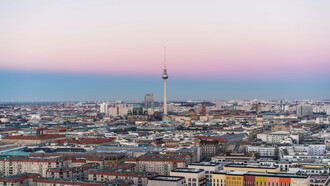In the middle of downtown Toronto, the Ontario College of Art and Design University (OCAD U) is not just one of Canada's oldest and most respected art and design schools—it's also the home of one of the city's most dramatic and recognizable architectural landmarks. Completed in 2004, the Rosalie Sharp Centre for Design floats dramatically above the city on a forest of brightly colored stilts. Designed by British architect Will Alsop in collaboration with Robbie/Young + Wright Architects of Toronto, the building balances innovative ambition with pragmatic design. What follows is an exploration of the dramatic form, bold structural choices, and symbolic significance of a modern landmark that leaves design hanging in the air.
Architectural design and features
At first glance, the Rosalie Sharp Centre is striking in its uncommon form. A large geometric volume, suspended approximately 26 meters above grade, is supported by 12 multi-colored steel columns. Black-and-white pixelated panels wrap the façade, giving the illusion of a hovering box. The multi-colored columns are not just structural but also defining visual elements of the design.
The form attempts to express that architecture is just as much about making statements as it is about shelter and enclosure. By minimizing its physical interaction with the ground, the building achieves a great public space below. This allows for social interaction and campus-city transition space. The building is therefore not just an educational building but also a social meeting area for the public.
Internally, flexibility is the preference. Open-plan studio spaces are augmented by a design that maximizes natural light. With minimal internal walls, the interior encourages a sense of freedom of creativity. Exposed material and vibrant color finishes blend to create a working but visually demanding environment. Gallery spaces, workshops, and multipurpose classrooms enable the creation and exhibition of students' work.
This design approach is directly related to the pedagogical philosophy of OCAD University. Art-, design-, and creativity-based, the university's pedagogical philosophy is given physical form in this new building. More than a container for learning, it is actively engaged in the process of learning.
Structural system
One of the building's most dramatic features—its elevated volume—required an innovative engineering response. The mass floating approximately 26 meters above grade is supported by 12 sloping steel pipe columns. The columns both support the structural load and contribute to the building's dynamic visual character. Each column was separately engineered and anchored to bespoke foundations.
The upper mass is formed with a steel truss framework, which is both heavy-duty and lightweight. It allows for wide, unbroken interior spans, thus making it possible to have large column-free spaces. The exterior panels are hung from this steel structure, which creates a continuous and cohesive façade. The columns, though structural, also serve the dramatic function of imparting the building's unique architectural character.
Recognition and awards
The path-breaking design of the building attracted international attention in a short period. The building received the Worldwide Award from the Royal Institute of British Architects (RIBA) in 2004 for its aesthetic and intellectual contribution to architectural thinking.
In 2005, the project won the Award of Excellence in the "Building in Context" category of the Toronto Architecture and Urban Design Awards. It was also honored by the Canadian Consulting Engineering Awards for technical excellence in building.
These awards are an indication of how significant the building is not only as an iconic architecture but also as an example of careful integration of design, engineering, and urban relationship. The Rosalie Sharp Centre is now more than a symbol for OCAD University—it's seen as a cultural and architectural landmark in Toronto.
Urban relationship and reception
When it was initially constructed, the building generated intense public reaction in Toronto. Though some referred to it as a "flying tabletop" or compared it to a Lego block, others praised its innovation and audacity. Over time, nevertheless, the building has been accepted and integrated into the city's architectural character.
At the urban scale, the Rosalie Sharp Centre for Design stands in stark contrast to more traditionally inspired environs. Rather than shy away from this contrast, it seizes the potential for the building to be a dramatic urban marker. In its relationship to the public space below it, the building is not only an academic building but a living, breathing part of the city.
Conclusion
OCAD University's Rosalie Sharp Centre for Design is a provocative example of the intersection of education, architecture, and public space. Challenging conventional form and expectation, the building offers students and guests an unusual spatial experience. Internationally celebrated, with innovative structural design and urban engagement, the Rosalie Sharp Centre continues to be one of the most significant examples of contemporary Canadian architecture.
This is beyond a building project—it's a multidimensional cultural icon that unites creativity, engineering, and education in a single elevated gesture on the Toronto skyline.













